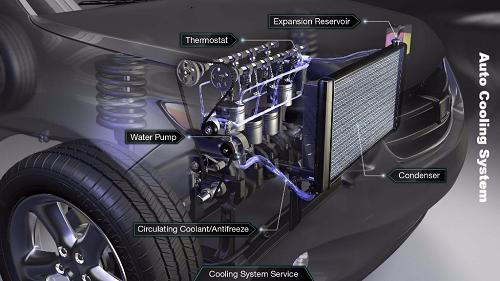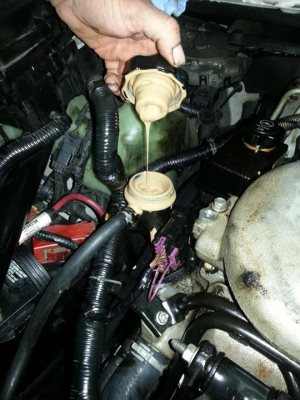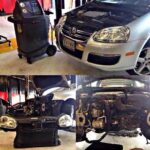Engine Overheating & Auto Cooling System Repair & Service

Auto Service Experts Engine Cooling System Specialists in San Antonio, TX
Auto cooling system problems (such as a radiator leak, coolant leak, or car overheating) can not only leave you stranded on the side of the road, but they are also a common cause of poor engine performance and even engine failure. The cooling system is responsible for helping the engine to quickly reach and then maintain the ideal operating temperature. Running above or below the proper operating temperature causes the engine to run less smoothly & efficiently, wastes fuel, and creates more pollution. The radiator, water pump, coolant, and thermostat work together to remove heat from the engine to prevent the vehicle from overheating. Overheating can cause major damage (such as cracked cylinder heads) which may require auto engine repairs or motor rebuilds. These components also work with the HVAC (heating, ventilation, & Air Conditioning) System to heat or cool cabin air allowing for increased passenger comfort. Have an Auto Service Experts ASE certified mechanic service and inspect your auto cooling system yearly to avoid major auto repairs such as a blown head gasket.
Contact Auto Service Experts auto repair shop to schedule your annual auto cooling system service today before the San Antonio summer heat arrives!
Auto Service Experts Auto Cooling System Inspection Includes:
- Belts – inspect for corrosion and signs of cracking
- Coolant – ensure that it is uncontaminated and provides adequate protection against overheating.
- Cooling Fan – test performance
- Fan Clutches – (if applicable)
- Radiator Cap – pressure test
- Check for Cooling System leaks at:
- Radiator
- Engine Heads
- Freeze Plugs
- Heater Core
- Hoses
- Intake Manifold
- Reservoir Tank
- Thermostat Housing
- Water Pump
Cooling System Maintenance Prevents Engine Overheating
The cooling system includes a radiator, water pump, thermostat, and heater core, which work together to prevent your car from overheating. These components rely on coolant (antifreeze), which travels through the system and cools the engine. Low or contaminated coolant prevents the system from operating correctly and causes damage, leading to overheating. If you fail to have your coolant replaced promptly, it becomes corrosive and eats away at cooling system components. It may also reach dangerously low levels due to leaks. Cooling system flushes help to keep these components operating correctly and can prevent engine repair down the road.
Auto Cooling System Components:
- Freeze Plugs – keep coolant from leaking out of the engine (these may expand or rust without proper cooling system maintenance)
- Heater Core – draws hot coolant from the water pump to heat the vehicle’s interior, then returns coolant to the engine
- Hoses – the “plumbing” that connects system components and transfers coolant through the cooling system
- Head Gaskets – seal the engine block to the cylinder heads, preventing liquids or gasses from escaping
- Pressure Cap – maintains pressure within the cooling system
- Radiator – lowers the temperature of coolant
- Radiator Fan – maintains airflow through the radiator when the vehicle is stopped or running slowly
- Reservoir Tank – captures coolant released by pressure cap
- Thermostat – regulates the flow of coolant to reach and maintain optimum engine operating temperature
- Transmission Cooler
- Water Pump – circulates coolant

Blown Head Gasket Repair due to Engine Overheating
How Auto Cooling System Components Operate
Radiator – The coolant is heated as it flows through the engine. Hot coolant is drawn in through the top inlet of the radiator through a rubber hose (upper radiator hose). Many radiators consist of aluminum tubes with fins that zigzag across them. Coolant travels down these tubes as the cooling fans push hot air from the radiator out and away from the vehicle. Once the coolant has been cooled back down, it is released through an outlet to return to the engine. Have a bad radiator replaced immediately to avoid overheating and costly engine damage.
Coolant – Coolant expands as it heats; this increases pressure within the cooling system. Because of its high concentration of ethylene glycol, coolant boils at a higher temperature than water. Coolant can reach temperatures of 250 degrees and higher before boiling when pressurized.
Pressure Cap – The pressure cap regulates the pressure within the cooling system. It equalizes pressure and maintains it at a constant level, which keeps the coolant boiling point consistent. A special spring-loaded valve releases excess pressure when it exceeds the preset pressure level. When this happens, some of the coolant drains out into a reservoir tank (coolant recovery tank), forming a partial vacuum in the cooling system. A secondary valve on the radiator cap allows this vacuum to pull coolant back out of the reservoir tank and into the radiator once it is cool.
Water Pump – The water pump circulates coolant through the auto cooling system. When the engine is running, the water pump is either gear-operated or powered by the timing belt, the fan belt, or the serpentine belt. A failing or leaking water pump requires immediate replacement to avoid major engine damage from overheating.
Thermostat – The thermostat monitors coolant temperature. When the coolant reaches high temperatures, a valve opens, letting the hot coolant pass into the radiator to be cooled. If it does not reach high enough temperatures, the valve remains closed. Instead, the coolant returns to the engine and helps heat it. Thermostats fail over time and prevent the cooling system from operating as needed. Thermostat replacements are minor repairs that prevent significant engine overheating damage, so always have it checked at the first sign of a problem.
*** If your vehicle needs a water pump replacement or thermostat replacement, you may also notice heating system problems. See our article on heater repair to learn how the cooling and heating systems are related.
The Heater Core – The heater core is attached to the cooling system by two hoses. Hot coolant enters the heater core through one of the hoses and flows back into the engine through another hose. The blower is a fan that pulls air through the heater core into heater ducts and, ultimately, into your vehicle to warm cabin air.
Blend Door – A blend door controls the temperature by mixing hot air with cold air from your auto AC system or outside. This lets you adjust the inside cabin air temperature, making it hotter or colder to your preference.

